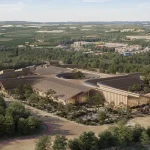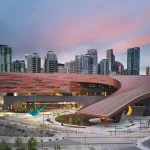Concept and Interaction
Rhubarb, designed by Atelier DARN, is built in the courtyard of Montpellier, France’s Hotel d’Aures, an 18th-century historical landmark. The installation emphasizes the capacity for transformation of the interactive and sustainable design. In keeping with the festival’s philosophy of bringing life to empty spaces and inspiring communal creativity.
Rhubarb keeps the active participation of spectators and is modeled after the rhythm and development of the Olympics. By flipping the roles of the audience and the artwork, it emphasizes this idea: guests enter the pavilion as the artwork, and the pavilion itself becomes a spectator, reflecting and mirroring their movements in the courtyard. The title of the piece, “Rhubarb,” indicates the background sounds that envelop a scene on a movie set, reflecting the understated yet essential quality of the audience’s collective voice.
Design and Materials
Rhubarb is a sound sculpture that combines elements to create an immersive art experience by transforming the viewer’s movements into a symphony of auditory experiences. The audience’s energy gives life to this interactive artwork, transforming their movements into a dynamic work of art complete with music and light displays. Simple acts of pushing, touching, or brushing hands over the pieces and creating wind can all constitute forms of interaction.
The location of Rhubarb in the courtyard of the Hotel d’Aures, an 18th-century historical monument, guarantees a mutually beneficial connection with natural light sources. Enthralling shadows flow across the stage as sunlight passes through various arrangements, highlighting the transient quality of architectural art.


Sustainability and Production
The installation contains one thousand pieces, all different in size and color. The wide range of colors alludes to the colors present in Montpellier and the courtyard, signifying the diversity and richness of humankind. Each object is 3D printed using eco-friendly filaments.
In an effort to be environmentally conscious, Rhubarb investigates sustainable production techniques using three different kinds of 3D print materials: industrial base filament Ultrafuse®TM rPET by BASF Forward AM, which is recycled from post-industrial PET waste; handcrafted PET filament made from PET bottles that are discarded from homes; and a novel plant-based material by NOVINOV that is derived from miscanthus and has biodegradable qualities.




















Leave a comment